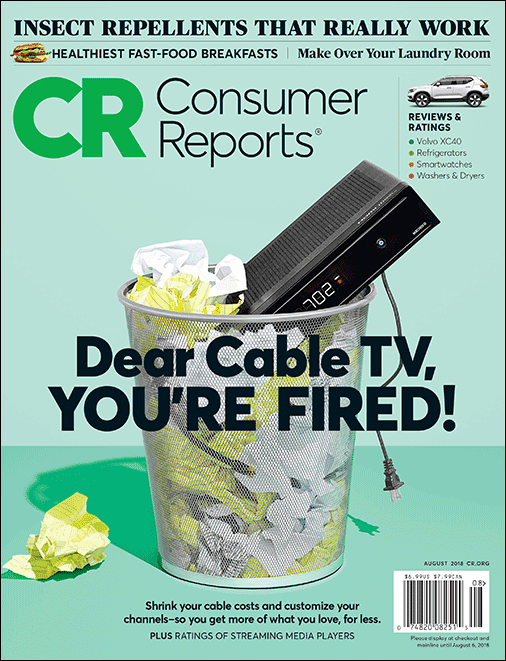'Consumer Reports' Guides Subscribers on Cord-Shaving
Consumer Reports magazine and its advocacy affiliate Consumers Union are ganging up this month on cable fees and bundling.

They've launched a "What's the Fee" (WTF) online assault on system operators, with Comcast as its first target. Meanwhile, the 12-page cover story, "Take Control of Cable TV," in Consumer Reports's August issue, lays out an eight-step plan for cord-cutting, or at least cord-shaving. The section includes advice on "cable replacement services," including streaming media.
The core element in the magazine report is a section on "Cable TV's Sneaky Fees," which is step one in Consumers Union's attack on extra fees that "inflate the costs" for purchases across industries ranging from utilities and airlines to entertainment and banks. The non-profit organization said a couple of weeks ago that it delivered "more than 110,000 petition signatures to Comcast ... calling on the company to address the issue" of extra fees.
In its tally of fees -- most of which CR contended should be included in the core bill -- the magazine totaled up to $71 in monthly fees, including sports surcharges, digital video recorder service, set-top boxes and "High Definition Technology" charges. In addition, cable bills include broadcast retransmission fees which, CR said, should be "baked into the advertised price."
“It’s time for Comcast and the cable industry as a whole to ditch these fees, and advertise the full price of their service so that consumers aren’t left asking ‘WTF?’ when they get their bill,” according to published reports of the comments by John Schwantes, senior policy counsel for Consumers Union.
Comcast responded, in a corporate statement to the Philadelphia Inquirer, that its "Xfinity bill was designed ... to make it simple to understand.” It insisted that “broadcast television and regional sports network fees are itemized" so that subscribers can "clearly see those costs." A company spokesman also told the local newspaper that consumers receive "a complete list of charges and fees ... as part of our sales process.”
Consumer Reports said it started its WTF campaign because complaints about cable fees are so frequent. It said that more than 25,000 of the petition signers identified Comcast as their biggest problem -- approximately reflecting the company's share of the total U.S. Multichannel Video Programming Distributor subscriber base.
The smarter way to stay on top of the multichannel video marketplace. Sign up below.
The campaign and the August cover story continue a decades-long look at cable by Consumers Union and Consumer Reports. As long ago as 1987 the magazine ran a "Cable TV" cover story, focused on questions such as, "Are the service and the programming worth the money?" In 2004, Consumers Union presented to policymakers the results of a nationwide survey that found two-third of cable subscribers wanted an à la carte "option to select the channels in their plan" and 30% "would pick fewer channels even without proportionate savings." When the Senate was deliberating cable legislation in 2009, CU pushed for unbundling channels so that decisions about what to buy "would be best left to consumers themselves."
Related: Roku Hits Back at ‘Consumer Reports’
Consumer Reports, which has about six million members/subscribers, has been the name of the parent membership organization since 2012, when it reorganized and made Consumers Union its political advocacy subsidiary. Prior to then, CU was the parent non-profit, with CR the monthly magazine and buyer's guide.
The August CR articles encourage viewers to consider a move to "free" over-the-air broadcasting, and includes a list of 10 recommended TV antennas to receive that service. It lays out packages of skinny bundles and over-the-top services (e.g., Netflix, Hulu, SlingTV and DirecTV Now) that separately or collectively could shave $100 or more from a monthly cable bill.
It also recommends that customers who want to move to a lower tier of cable TV service should "bypass regular customer service and ask to speak to a customer retention specialist" when they contact their local provider.
Another sidebar in the long report recommends "The Best Streaming Media Players." The report acknowledges that customers would still need to buy a broadband access service (probably from the cable carrier) and could be subjected to future price or packaging revisions.
Contributor Gary Arlen is known for his insights into the convergence of media, telecom, content and technology. Gary was founder/editor/publisher of Interactivity Report, TeleServices Report and other influential newsletters; he was the longtime “curmudgeon” columnist for Multichannel News as well as a regular contributor to AdMap, Washington Technology and Telecommunications Reports. He writes regularly about trends and media/marketing for the Consumer Technology Association's i3 magazine plus several blogs. Gary has taught media-focused courses on the adjunct faculties at George Mason University and American University and has guest-lectured at MIT, Harvard, UCLA, University of Southern California and Northwestern University and at countless media, marketing and technology industry events. As President of Arlen Communications LLC, he has provided analyses about the development of applications and services for entertainment, marketing and e-commerce.

